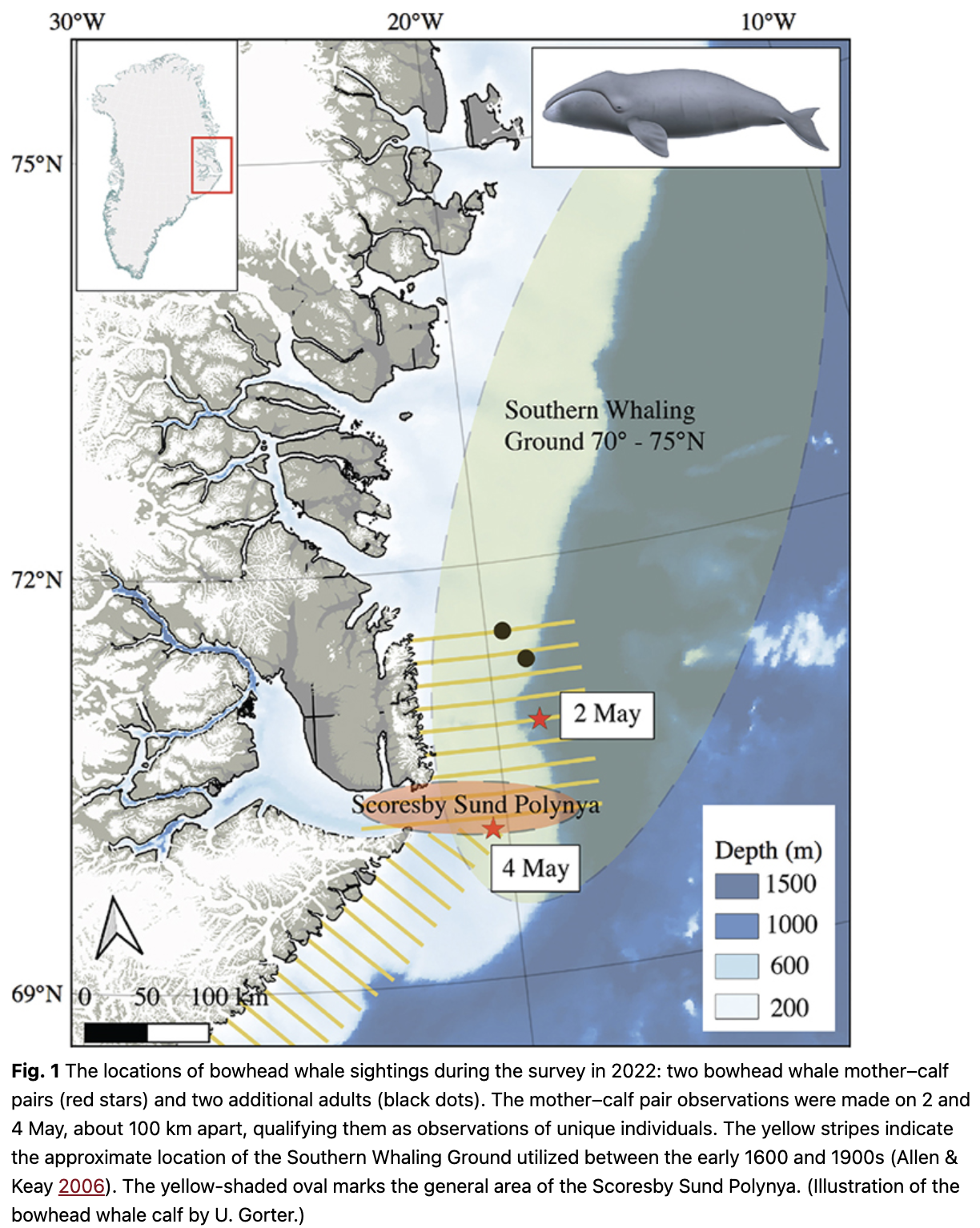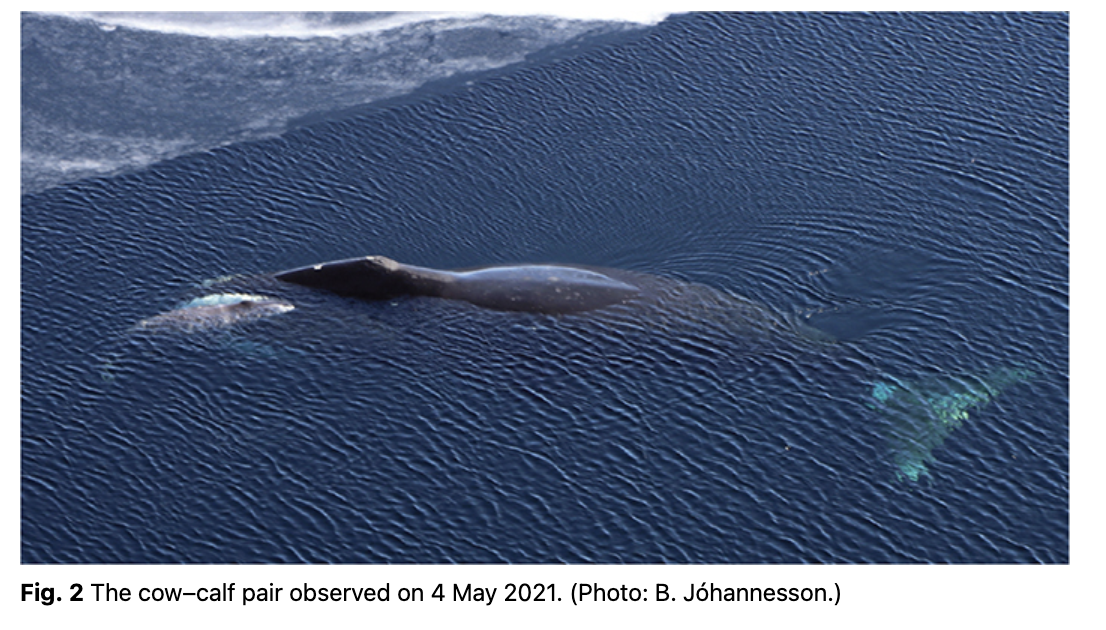Possible signs of recovery of the nearly extirpated Spitsbergen bowhead whales: calves observed in east Greenland


Опубликована Янв. 1, 2023
Последнее обновление статьи Июль 25, 2023
Abstract
The Spitsbergen population of bowhead whales (Balaena mysticetus) was harvested to near extinction during the whaling era. Here, we show possible signs of recovery of the population by reporting observations of two calves in the Scoresby Sund polynya in East Greenland on 2 and 4 May 2022, and it is the first observation of this kind in this area since the early 1900s.
Ключевые слова
Balaena mysticetus, endangered, calf, Spitsbergen population
Introduction
The Spitsbergen population of bowhead whales (Balaena mysticetus) is listed as Endangered on the International Union for Conservation of Nature Red List (Cooke & Reeves 2018). The population, which once ranged from the East Greenland Sea across the northern Barents region into Russian waters in the North Atlantic and numbered between 25 000 and 100 000 individuals (Allen & Keay 2006), was hunted to near extinction during the whaling era from the 1600s to the early 1900s (Ross 1993). Population estimates since have ranged from only a few tens of individuals to some hundred individuals (Gilg & Born 2005; Boertmann et al. 2015). The part of the population of bowhead whales residing in the Northeast Water, off east Greenland, a former northern whaling ground, is currently estimated to consist of about 300 individuals (Vacquié-Garcia et al. 2017; Hansen et al. 2017).
During recent decades, bowhead whales have been seen with increasing frequency throughout their former distribution range (Gilg & Born 2005; Boertmann et al. 2009; Lydersen et al. 2012; Boertmann et al. 2015; De Boer et al. 2019), but the concurrent increase in survey effort has left doubt about an actual increase in abundance. In the summer of 2009, a calf was seen in the Northeast Water off east Greenland, providing evidence for reproduction in the population (Boertmann & Nielsen 2010). This observation was the second observation of a calf in the Spitsbergen population of bowhead whales since 1981 and the first of its kind in the western part of their range (Boertmann & Nielsen 2010). Here, we provide further evidence for reproduction in the population by reporting observations of two bowhead whale calves in the Greenland Sea, about 1000 km south of the previous observation.
Observations
A visual aerial line transect survey of marine mammals, following the methodology described by Hansen et al. (2017), was conducted in the Scoresby Sund Polynya and adjacent coastal areas between 67.8°N and 71.5°N from 1 to 6 May 2022. Two bowhead whale mother–calf pairs were observed, one on 2 May (70°50’6.36”N, 19°2’21.12”W) and one on 4 May 2022 (70°5’1.32”N, 20°19’8.4 W), in the so-called Southern Whaling Ground (Fig. 1). The whales were observed about 140 m from the transect line on both occasions.

The calves were grey in colour and were approximately one-quarter of the length of the mothers (Fig. 2). We have pictures of only the cow calf pair observed on 4 May. Bowhead whale females >13.5 m in length are considered sexually mature (Koski et al. 1993), and we estimate that the female observed on 4 May (Fig. 2) was 14–16 m in length. The presence of white on the peduncle and several scars on the back and rostrum of the mother suggest that she was not a young whale (B. Koski, pers. comm.). Bowhead whale calves are 4.0–4.5 m long at birth (Koski et al. 1993; Heide-Jørgensen et al. 2012), with an early growth rate of 1.5 cm/day (Koski et al. 1993). Judging by its light grey colouring and small size, the calf seen on 4 May was deemed likely to be in the range of newborn to a few weeks in age and unlikely older than one month (B. Koski, pers. comm.).

Both of the pairs were observed resting at the surface in a lead surrounded by dense sea ice (90% ice coverage), which appears to be common for bowhead whale cows with neonates (B. Koski, pers. comm.). This suggests that the calf was born in late April or early May, which agrees with the old whaling records of neonate bowhead whales in the Greenland Sea (Scoresby 1820, cited by Reeves & Leatherwood 1985) and with the most recent sighting of a calf in 2009 (Boertmann & Nielsen 2010). Additional two adult bowhead whales were observed during the survey (Fig. 1).
Recent satellite tracking has shed light on the habitat use and movements of the Spitsbergen population of bowhead whales (Lydersen et al. 2012; Kovacs et al. 2020). The whales were strongly affiliated with cold water and sea ice throughout the year and exhibited an unusual springtime migration from north-to-south, into the Southern Whaling Ground and the Scoresby Sund Polynya area (Lydersen et al. 2012; Kovacs et al. 2020), where the observations of calves reported here were made (Fig. 1). This migration has been suggested to be related to prey distribution (Gray 1931, cited by Lydersen et al. 2012). In the polynyas, surface water is exposed to solar radiation in the spring earlier than the surrounding ice-covered waters, providing favourable conditions for a concentrated plankton bloom (Tremblay et al. 2002). Bowhead whales have also been shown to utilize dense ice coverage as an anti-predator tactic against killer whales (Orcinus orca; e.g., Ferguson et al. 2010; Matthews et al. 2020). The Scoresby Sund Polynya fulfils the main characteristics of an ideal calving ground: prey, cold water and protection from predators. It remains to be seen if the two observations of calves reported here are a beginning of a positive trend in the abundance of Spitsbergen bowhead whales and an indicator of a calving ground for this endangered population.
Acknowledgements
We thank Bill Koski, LGL Limited, for his insights and advice on aging the calves. Ana Rodrigues and an anonymous reviewer are thanked for their valuable feedback, which greatly improves this research note. Norlandair pilots J. Jonsson Gentry and B. Jóhannesson are thanked for skilful flying and photography.





